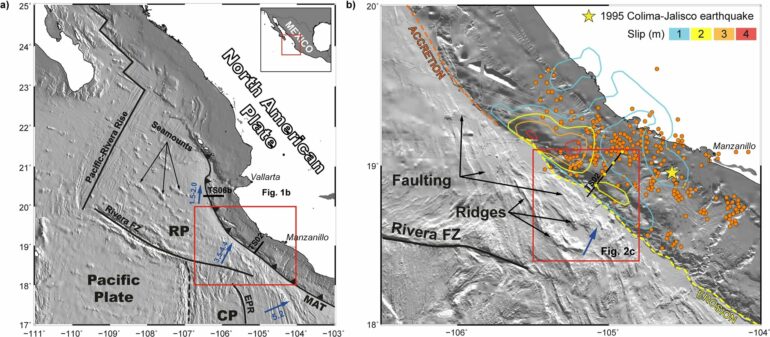The Northwest Pacific coast of Mexico is an area struck by large earthquakes and tsunamis as a result of the interaction of two tectonic plates. However, to date, the structure of the continental margin and, therefore, the causes behind the generation of these natural hazards were unknown.
Now, a new study by the Institut de Ciències del Mar (ICM-CSIC) in Barcelona has unveiled the most detailed seismic image of this section of the Pacific coast, where up to three large tsunamigenic earthquakes—that generate tsunamis—of magnitude 8 have been recorded in the last 100 years.
Specifically, the work, carried out in collaboration with the Univerdidad Nacional Atónoma de México (UNAM), reveals for the first time the structure beneath the Jalisco-Colima continental margin, unveiling the presence of large oceanic ridges that subduct beneath the North American continental plate. According to the authors, this helps explain the high seismogenic and tsunamigenic potential of the region and will help define the areas of greatest hazard.
“The results of the study reveal the mechanisms that explain the propagation to the seafloor of earthquakes that are generated at great depths and end up causing large tsunamis. In addition, this study allows to estimate more accurately the rupture velocity and the maximum slip of the fault in the event of an earthquake, two parameters that are key for understanding how tsunamis are generated in this region and to be able to predict their impact on the coast,” explains Manel Prada, the lead author of the study.
To develop the work, recently published in the journal Communications Earth & Environment, the team combined geophysical data obtained during the TSUJAL oceanographic survey, carried out in 2014 off the coasts of Jalisco and Colima thanks to a collaboration with the Ocean Facilities Exchange Group (OFEG).
“This new seismic data processing and modeling approach has allowed us to improve the final resolution of the crustal image in northwestern Mexico. We have also been able to obtain the relief of the boundary between both tectonic plates and physical properties variations down to 10 km depth at a higher resolution than previously provided by conventional techniques,” states Rafael Bartolomé, another of the study’s co-authors.
All in all, the work provides a new methodology that could be applied in other regions with similar seismological conditions, especially in continental margins shaped by subduction zones with low sediment accumulation such as those found in Central and South America, to assess the role of the oceanic plate relief in the generation of large earthquakes and tsunamis.
More information:
Manel Prada et al, Trench-parallel ridge subduction controls upper-plate structure and shallow megathrust seismogenesis along the Jalisco-Colima margin, Mexico, Communications Earth & Environment (2023). DOI: 10.1038/s43247-023-00705-9
Provided by
Spanish National Research Council
Citation:
Study unveils the mechanism behind the generation of large tsunamis off the Northwest Mexican coast (2023, March 7)



